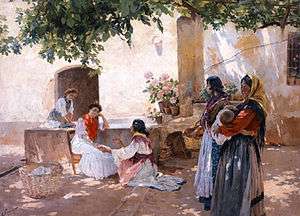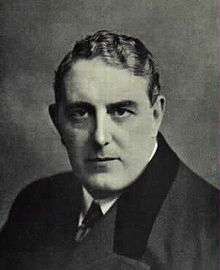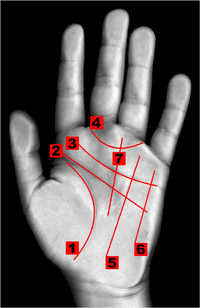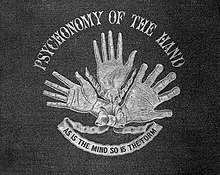Palmistry
Palmistry, or chiromancy (also spelled cheiromancy; from Greek kheir (χεῖρ, ός; "hand") and manteia (μαντεία, ας; "divination")), is the claim of characterization and foretelling the future through the study of the palm, also known as chirology, or in popular culture as palm reading. The practice is found all over the world, with numerous cultural variations. Those who practice chiromancy are generally called palmists, hand readers, hand analysts, or chirologists.
_02.jpg)

There are many—often conflicting—interpretations of various lines and palmar features across various schools of palmistry. The majority of Academics are against palmistry, although it is symbolized in the Hamza symbol in Judaism, practiced by the highest Hindu caste Brahminis, and is also discussed in the Book of Job 37:7 indirectly.[1] The contradictions between different interpretations, as well as the lack of evidence for palmistry's predictions, have caused palmistry to be viewed as a pseudoscience by academics.[2][3]
History

Ancient palmistry
Palmistry is a practice common to many different places on the Eurasian landmass;[4] it has been practised in the cultures of India, Nepal, Tibet, China, Persia, Sumeria, Palestine and Babylonia.
The acupuncturist Yoshiaki Omura describes its roots in Hindu astrology (known in Sanskrit as jyotish), Chinese Yijing (I Ching), and Roma fortune tellers.[5] Several thousand years ago, the Hindu sage Valmiki is thought[6] to have written a book comprising 567 stanzas, the title of which translates in English as The Teachings of Valmiki Maharshi on Male Palmistry.[6][7] From India, the art of palmistry spread to China, Tibet, Egypt, Persia and to other countries in Europe.[5][8]
From India, palmistry progressed to Greece where Anaxagoras practiced it.[5] Aristotle (384–322 B.C.E.) discovered a treatise on the subject of palmistry on an altar of Hermes, which he then presented to Alexander the Great (356–323 B.C.E.), who took great interest in examining the character of his officers by analyzing the lines on their hands.[9]
During the Middle Ages the art of palmistry was actively suppressed by the Catholic Church as pagan superstition. In Renaissance magic, palmistry (known as "chiromancy") was classified as one of the seven "forbidden arts", along with necromancy, geomancy, aeromancy, pyromancy, hydromancy, and spatulamancy (scapulimancy).[10]
Modern palmistry

Palmistry experienced a revival in the modern era starting with Captain Casimir Stanislas D'Arpentigny's publication La Chirognomie in 1839.[8]
The Chirological Society of Great Britain was founded in London by Katharine St. Hill in 1889 with the stated aim to advance and systematise the art of palmistry and to prevent charlatans from abusing the art.[11] Edgar de Valcourt-Vermont (Comte C. de Saint-Germain) founded the American Chirological Society in 1897.
A pivotal figure in the modern palmistry movement was the Irish William John Warner, known by his sobriquet, Cheiro. After studying under gurus in India, he set up a palmistry practice in London and enjoyed a wide following of famous clients from around the world, including famous celebrities like Mark Twain, W. T. Stead, Sarah Bernhardt, Mata Hari, Oscar Wilde, Grover Cleveland, Thomas Edison, the Prince of Wales, General Kitchener, William Ewart Gladstone, and Joseph Chamberlain. So popular was Cheiro as a "society palmist" that even those who were not believers in the occult had their hands read by him. The skeptical Mark Twain wrote in Cheiro's visitor's book that he had "…exposed my character to me with humiliating accuracy."
Edward Heron-Allen, an English polymath, published various works including the 1883 book, Palmistry – A Manual of Cheirosophy, which is still in print.[8][12] There were attempts at formulating some sort of scientific basis for the art, most notably in the 1900 publication "The Laws of Scientific Hand Reading" by William G. Benham.[13]
Techniques
Chiromancy consists of the practice of evaluating a person's character or future life by "reading" the palm of that person's hand. Various "lines" ("heart line", "life line", etc.) and "mounts" (or bumps) (chirognomy) purportedly suggest interpretations by their relative sizes, qualities, and intersections. In some traditions, readers also examine characteristics of the fingers, fingernails, fingerprints, and palmar skin patterns (dermatoglyphics), skin texture and color, shape of the palm, and flexibility of the hand.
A reader usually begins by reading the person's dominant hand (the hand they write with or use the most, which is sometimes considered to represent the conscious mind, whereas the other hand is subconscious). In some traditions of palmistry, the other hand is believed to carry hereditary or family traits, or, depending on the palmist's cosmological beliefs, to convey information about "past-life" or "karmic" conditions.
The basic framework for "classical" palmistry (the most widely taught and practiced tradition) is rooted in Greek mythology. Each area of the palm and fingers is related to a god or goddess, and the features of that area indicate the nature of the corresponding aspect of the subject. For example, the ring finger is associated with the Greek god Apollo; characteristics of the ring finger are tied to the subject's dealings with art, music, aesthetics, fame, wealth, and harmony.
But as records of history suggest, it might also be possible for palmistry to have originated in the Sanatan Dharma or the Indic Civilization and further carried over to the Greeks. Cheiro himself has said that he got the knowledge from studying palmistry in an Indian village named Konkan.
Hand shape
Depending on the type of palmistry practiced, and the type of reading being performed, palmists may look at various qualities of the hand, including the shapes and lines of the palm and fingers; the color and texture of the skin and fingernails; the relative sizes of the palm and fingers; the prominence of the knuckles; and numerous other attributes of the hands.
In most schools of palmistry, hand shapes are divided into four or eleven major types, sometimes corresponding to the classical elements or temperaments. Hand shape is believed to indicate character traits corresponding to the type indicated (i.e., a "Fire hand" would exhibit high energy, creativity, short temper, ambition, etc. – all qualities believed to be related to the classical element of Fire).
Although variations abound, the most common classifications used by modern palmists:
- Earth hands are generally identified by broad, square palms and fingers, thick or coarse skin, and ruddy color. The length of the palm from wrist to the bottom of the fingers is usually equal to the length of the fingers.
- Air hands exhibit square or rectangular palms with long fingers and sometimes protruding knuckles, low-set thumbs, and often dry skin. The length of the palm from wrist to the bottom of the fingers is usually equal to the length of the fingers.
- Water hands are seeable by the long, sometimes oval-shaped palm, with long, flexible, conical fingers. The length of the palm from wrist to the bottom of the fingers is usually less than the width across the widest part of the palm, and usually equal to the length of the fingers.
- Fire hands are characterized by a square or rectangular palm, flushed or pink skin, and shorter fingers. The length of the palm from wrist to the bottom of the fingers is usually greater than the length of the fingers.
The number and quality of lines can also be included in the hand shape analysis; in some traditions of palmistry, Earth and Water hands tend to have fewer, deeper lines, while Air and Fire hands are more likely to show more lines with less clear definition.
Lines

1: Life line; 2: Head line; 3: Heart line; 4: Girdle of Venus; 5: Sun line; 6: Mercury line; 7: Fate line
The three lines found on almost all hands, and generally given most weight by palmists:
- The heart line is the first of the major lines examined by a reader and represents love and attraction.[14] It is found towards the top of the palm, under the fingers. In some traditions, the line is read as starting from the edge of the palm under the little finger and flowing across the palm towards the thumb; in others, it is seen as starting under the fingers and flowing toward the outside edge of the palm. Palmists interpret this line to represent their subject's emotional life; it is therefore believed to give an insight into how the emotional side of their mindframe will act out and be acted upon during their lifetime. The line is also claimed to indicate romantic perspectives and intimate relationships; for example, a chained or gridded heart line is said to point to a flirtatious attitude to love, one which can be prone to fall in love easily. The heart line is said to be indirectly associated with heart health: a chained heart line is purportedly associated with high blood pressure, or with an 'adrenaline junkie' attitude in life.
- The next line identified by palmists is the head line. This line starts at the edge of the palm under the index finger and flows across the palm towards the outside edge. Often, the head line is joined with the life line (see below) at inception. Palmists generally interpret this line to represent their subject's mind and the way it works, including learning style, communication style, intellectualism, and thirst for knowledge. It is also believed to indicate a preference for creative or analytical approaches to information (i.e., right brain or left brain).
- The life line is perhaps the most controversial line on the hand. This line extends from the edge of the palm above the thumb and travels in an arc towards the wrist. This line is believed to represent the person's vitality and vigor, physical health and general well being. The life line is also believed to reflect major life changes, including cataclysmic events, physical injuries, and relocations. Modern palmists generally do not believe that the length of a person's life line is tied to the length of a person's life.
- The combined length of these three main lines (heart, head, life) can also be of interest. It is said that if this combined length is longer than the subject's foot, they may be overbearing, and if it is shorter they may give in too easily to other people, whereas a similar length suggests a well balanced individual.
Additional major lines or variations include: A simian crease, or fusing of the heart and head lines, has special significance, since this single line must be read to infer details about a subject's emotional and reasoning nature. According to Cheiro, this line is thought to endow a person with an intensity of purpose or single-mindedness, the nature of which is decided upon by exact position of this line on the hand and the direction of any branches shooting from it. In hands where such a line exists without any branches as a singular mark, it is taken to indicate an extremely intense nature and special care is needed for such persons.
The normal position for the simian crease is starting below the index finger and ending where normally the heart line terminates at the edge of the hand below the little finger. The upper part of the palm lying immediately below the fingers is considered to represent the higher or intellectual nature and the lower part of the palm to represent the materialistic side of the nature. If one of these parts is larger than the other, as decided by the central placement of the simian crease, it shows greater development of that aspect of the nature.
Based on this general principle, if the simian crease is placed below its normal position it indicates an intensely intellectual nature. If it is placed above its normal position it indicates an intensely materialistic nature and interests. The direction in which any branches may be found shooting from this line are used to infer more details about the subject's temperament.
The fate line runs from the bottom of the palm near the wrist, up through the center of the palm towards the middle finger. This line is believed to be tied to the person's life path, including school and career choices, successes and obstacles. Sometimes this line is thought to reflect circumstances beyond the individual's control, or alternately the person's choices and their consequences.
Jupiter, Saturn, Apollo, Mercury, Mars positive, Mars negative, plain of Mars, Luna mount, Neptune mount, Venus mount[15]
Other minor lines:
- Sun line: Parallel to the Fate Line, under the ring finger; believed to indicate fame or scandal
- Girdle of Venus: Starts between the little and ring fingers, runs in a rough arc under the ring and middle fingers to end between the middle and pointer fingers; thought to relate to emotional intelligence and the ability to manipulate
- Union lines: Short horizontal lines found on the percussive edge of the palm between the Heart Line and the bottom of the little finger; believed to indicate close relationships, sometimes—but not always—romantic.
- Mercury line: Runs from the bottom of the palm near the wrist, up through the palm towards the little finger; purported to be an indicator of persistent health issues, business acumen, or skill in communication.
- Travel lines: These are horizontal lines found on the percussive edge of the palm between the wrist and the heart line; each line is said to represent a trip taken by the subject—the longer the line, the more important the trip is to the subject.
- Other markings: These include stars, crosses, triangles, squares, tridents, and rings under each of the fingers; their supposed impact and meaning varies by location on the palm and freedom from other interfering lines.
- "Apollo line": The Apollo line is said to represent a fortunate life; it travels from the Mount of the Moon at the wrist to beneath the Apollo finger.
Criticism
Criticism of palmistry often rests with the lack of empirical evidence supporting its efficacy. Scientific literature typically regards palmistry as a pseudoscientific or superstitious belief.[16] Psychologist and noted skeptic Ray Hyman has written:
I started reading palms in my teens as a way to supplement my income from doing magic and mental shows. When I started I did not believe in palmistry. But I knew that to "sell" it I had to act as if I did. After a few years I became a firm believer in palmistry. One day the late Stanley Jaks, who was a professional mentalist and a man I respected, tactfully suggested that it would make an interesting experiment if I deliberately gave readings opposite to what the lines indicated. I tried this out with a few clients. To my surprise and horror my readings were just as successful as ever. Ever since then I have been interested in the powerful forces that convince us, reader and client alike, that something is so when it really isn’t.[17]
Skeptics often include palmists on lists of alleged psychics who practice cold reading. Cold reading is the practice that allows readers of all kinds, including palmists, to appear psychic by using high-probability guessing and inferring details based on signals or cues from the other person.[18][19]
In media
Palmistry has been shown in a number of books, films and television shows, including:
- Fun and Fancy Free (1947 cartoon) – In Mickey and the Beanstalk, Mickey reads the giant's palm.
- Are You Being Served? (1975 TV episode) – In the third series premiere, Mr. Humphries (played by John Inman) reads an Asian customer's hand, foretelling an accident. Later on, it does happen.
- Teen Witch (1989 film) – While Robyn Lively's character has her palm read, the fortune teller recognizes her as reincarnated witch who will soon be coming into her powers
- Jacob's Ladder (1990 film) – Tim Robbins' character has his palm read at a party, which acts as an ominous portent
- Clownhouse (1989 film) – The protagonist goes in a Fortune Teller's hut in the circus and the fortune teller tells him what his palms read and finds one severed and said his lifeline will soon be cut through.
- Love Potion No. 9 1992 film staffing Anne Bancroft, Sandra Bullock and Tate Donovan. Paul Matthews (Tate Donovan) is a lonely biochemist with a crush on his unavailable co-worker, biologist Diane Farrow (Sandra Bullock). His friends take him to a gypsy on 34th and Vine named Madame Ruth (Anne Bancroft) (as in the song of the same name). After reading his palm and seeing absolutely no romance in his life, Ruth gives him a small amount of Love Potion No. 8 on a piece of paper. Love Potion No.9 ends up being a potion to "purify" what comes from Potion No. 8.
- The Simpsons (1992 TV episode) – Palmistry is lampooned in the Season 4 Episode 8 New Kid on the Block.
- Before Sunrise (1995 film) – Julie Delpy's character has her palm read, while Ethan Hawke's character is sidelined, leading to a cynical rant from his character
- The Hunchback of Notre Dame (1996 film) – When Quasimodo tells Esmeralda he's a monster, she reads his palm and sees no "monster lines".
- Harry Potter and the Prisoner of Azkaban (1999 novel) – Harry Potter takes a course on divination and dabbles in palmistry.
- The Simian Line (2001 film) – Readings by a quirky psychic set in motion the main plot of the film
- Eat Pray Love (2010 film) – Julia Roberts's character goes in for a palmistry reading which transforms her life
- Amaya (2011 TV series) – Through the use of Himalad (Palmistry) the priestess found out that Amaya is the chosen one – the girl with a twin snake who will kill the ferocious Rajah.
See also
References
- https://www.biblestudytools.com/nkjv/job/37-7.html
- Park, Michael Alan. (1986). Palmistry or HandJive? In Science Confronts the Paranormal. Kendrick Frazier. Prometheus Books. pp. 198–2010. ISBN 978-1-61592-619-0
- Chamorro-Premuzic, Tomas; Furnham, Adrian. (2010). The Psychology of Personnel Selection. Cambridge University Press. p. 19. ISBN 978-0-521-86829-7 "A more popular pseudoscience is chiromancy (or palmistry), the art of characterisation and foretelling the future through the study of the palm."
- Dwivedi. Wonders of Palmistry pp. 16–20
- Omura. Acupuncture. pp.172 -174. According to this theory, palmistry developed in India and then extended across the world.
- Dwivedi. Wonders of Palmistry pp. 25–26
- Sharma. The A-Z of Palmistry. p. 95
- Chinn. Technology. p.24. "it was not until the mid- to late nineteenth century that palmreading took off in Britain, France and the United States thanks to three major figures: Casimir Stanislas d'Arpentigny, Edward Heron-Allen and Cheiro."
- James, Brandon. "PALMISTRY". Retrieved 20 February 2012.
- Johannes Hartlieb (Munich, 1456) The Book of All Forbidden Arts; quoted in Láng, p. 124.
- "The London Cheirological Society".
- Heron-Allen. Palmistry
- "PALMISTRY ~ ORIGINS & HISTORY" (PDF).
- "Palmistry". Mystic Scripts. Retrieved 20 February 2012.
- Sara Sirolli – Palmistry diagram of hand 2008
- Preece, P. F., & Baxter, J. H. (2000). Scepticism and gullibility: The superstitious and pseudo-scientific beliefs of secondary school students. International Journal of Science Education, 22(11), 1147–1156.
- Hyman, Ray. (1976–77). Cold Reading: How to Convince Strangers That You Know All about Them. Zetetic 1(2):18–37.
- David Vernon. In Skeptical – A Handbook of Pseudoscience and the Paranormal. Editors: Donald Laycock, David Vernon, Colin Groves, Simon Brown, Imagecraft, Canberra, 1989, ISBN 0-7316-5794-2, p. 44.
- Steiner, Bob. (2002). Cold Reading. In Michael Shermer. The Skeptic Encyclopedia of Pseudoscience. ABC-CLIO. pp. 63–66. ISBN 1-57607-654-7
Further reading

- Magda van Dijk-Rijneke Universal Hand Analysis, 2017 Elmar Publishers ISBN 9789038925912
- Chauran, Alexandra (2013). Palmistry Every Day. Llewellyn Worldwide. ISBN 978-0-7387-3494-1.
- Saint-Germain, Comte C. de. Practical Palmistry. Laird & Lee Publishers; Chicago, 1897.
- Heron-Allen, Edward (2008). Palmistry - A Manual of Cheirosophy (reprint ed.). Baltzell Press. ISBN 978-1-4437-6535-0.
- Chinn, Sarah E. (2000). Technology and the logic of American racism. Continuum. ISBN 978-0-8264-4750-0.
- Yoshiaki Omura (2003). Acupuncture Medicine: Its Historical and Clinical Background. Dover Publications Inc. ISBN 978-0-486-42850-5.
- Cheiro. Palmistry for All at Project Gutenberg
- Doublepalm+ project The Doublepalm+ project is a non-profit site about making palm reading with people on the web more like palm reading in the real world.
- Hari Dutta Sharma (1995). The A-Z of Palmistry. New Delhi, India: Sterling Publishers Pvt.Ltd. ISBN 978-81-207-1661-2.
- Bhorai Dwivedi (1970). Wonders of Palmistry. New Delhi: Diamond Pocket Books. ISBN 978-81-284-0099-5.